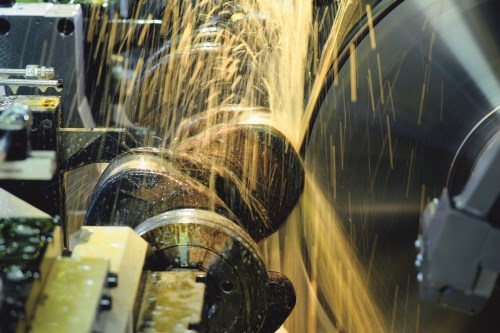Large-Part Grinding: Two Key Technologies
Developments in steady rest and in-process measurement technologies enable effective grinding of huge crankshafts.
Share






Advances in steady rest and in-process measurement technologies enable large crankshafts to be ground complete in one setup.
Junker, manufacturer of high-speed CBN grinding machines, has developed its new JuCrank series for cylindrical and non-cylindrical grinding for large crankshafts. The series offers a swing diameter of 470 mm and a part length capacity of up to 4.8 m, and can accommodate crankshafts that can weigh as much as 1,000 kg. Because these parts are so big and unwieldy, the company integrated two technologies to streamline setup and processing.
First, Junker developed its own steady rest system, believing that existing systems were too bulky and not rigid enough for high-speed grinding. These new steadies are CNC-controlled and have only one axis each, which is said to increase their stability and stiffness. A maximum of 11 steadies can be controlled individually and applied to a section at any time—even during the grinding process—to enable higher sequence flexibility.
Second, the company integrated an in-process measurement system. That’s because large crankshafts are mainly produced in small batches (in some cases as single pieces), and the forging and hardening costs are so high that scrapping a part is not an option.
To start the crankshaft grinding process, the machine’s two wheels, each mounted on a wheelhead with its own X and Z axis, pre-grind the main and pin bearings. Those diameters are measured during the process, and then the entire workpiece is measured after pre-grinding, including features such as the taper of each element, the bearing widths and lift heights.
Based on the measuring data, the machine completes the grinding process while using the WK axis whereby the grinding spindle swivels to compensate for tapers. The machine can also provide each main and pin bearing with its own profile shape with specific crowning. If necessary, the shaft ends can also be ground, which also often feature a taper. As a result, the crankshaft is ground complete in one setup.
Another application for the JuCrank machines is re-grinding of used crankshafts, whereby the crankshafts are ground based upon the measurements taken by the machine. This grinding platform also can be effective for other large-scale applications, such as printing rollers and electric motor shafts.
Related Content
-
Ballbar Testing Benefits Low-Volume Manufacturing
Thanks to ballbar testing with a Renishaw QC20-W, the Autodesk Technology Centers now have more confidence in their machine tools.
-
CNC Machine Shop Honored for Automation, Machine Monitoring
From cobots to machine monitoring, this Top Shop honoree shows that machining technology is about more than the machine tool.
-
Lean Approach to Automated Machine Tending Delivers Quicker Paths to Success
Almost any shop can automate at least some of its production, even in low-volume, high-mix applications. The key to getting started is finding the simplest solutions that fit your requirements. It helps to work with an automation partner that understands your needs.
























